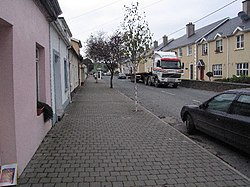Kilbrittain
| Kilbrittain Irish: Cill Briotáin | |
| County Cork | |
|---|---|
 Kilbrittain main street | |
| Location | |
| Grid reference: | W561512 |
| Location: | 51°40’24"N, 8°41’17"W |
| Data | |
| Population: | 216 (2016) |
| Local Government | |
Kilbrittain or Killbrittain is the name of a village and townland in County Cork, five miles south-west of Bandon, and near Clonakilty and Kinsale.
The coastal route around the edge of the parish is the R600 road: the village itself though is around a mile inland of the coast.
The name of the village is not an incitement to tribal hatred, but from the Irish Cill Briotáin, meaning 'Britton's church'.[1]
History
Local estates
Kilbrittain Castle is reputed to be one of the oldest inhabited castles in Ireland.[2] The castle is thought to date from 1035 where the original fortress may have been built by the O'Mahony clan. Known to have been in the hands of the Norman family of de Courcey and possibly extended in the 13th century, Kilbrittain Castle was the principal seat of MacCarthy Reagh family, Princes of Carbery and Kings of Desmond, from the early 15th century. The castle was extensively restored and enlarged by the Stawell family in the 18th and 19th centuries.[3] It was partially burned in 1920 and restored in 1969 by inventor Russell Winn. Kilbrittain Castle is now the home of the Cahill-O'Brien family.
Howes Strand is a beach in Kilbrittain with the ruin of a Coast Guard station that overlooks the beach, built in 1910 and burnt down in 1920.[4]
Coolmain Castle was originally built by the de Courcey family in the early 15th century, but they lost it to the MacCarthy Reaghs the following century. Over the years it passed through the hands of a number of families, including that of the Earls of Cork. In the middle of the 17th century, Oliver Cromwell acquired the property. In the early 1900s it was owned by the novelist Donn Byrne,[5] and was bought by Roy E. Disney in the 1990s.[6]
The Book of Lismore
It is believed that the Book of Lismore was compiled in the 15th Century to commemorate the marriage of the Gaelic prince Finghin Mac Cárthaigh Riabhach, of Kilbrittain Castle, to Caitilín, daughter of the seventh Earl of Desmond. The mediæval manuscript contains 166 large vellum folios of material that a learned person of the time would have been expected to know. It later became known as Leabhar Mhic Cárthaigh Riabhaigh. MacCarthy was patron of the friary at Timoleague, and some of the book's pages were copied there in 1629 by the scribe Mícheál Ó Cléirigh.
During a raid on Kilbrittain in 1642, the book was taken by Lewis, Lord Kinalmeaky, of Lismore who sent it back to his father, with a letter, at Lismore Castle. The book remained there until it was discovered behind a wall at the castle in 1814, during rebuilding works.
The Book of Lismore is written in Irish, but not the modern version spoken today. It is written on vellum, made from calfskin, an expensive material at the time of the book's writing, in the 15th century. The Book of Lismore contains many important texts, including a cosmological work, the Ever-new Tongue; the most extensive account of the lives of the saints in an Irish-language mediæval manuscript; an Irish translation of the travels of Marco Polo; and one of the greatest compositions of the Fenian Cycle, Acallam na Senórach, or The Conversation of the Old Men. The illustrated capitals are thought to have been added in the 19th century by Donnchadh Ó Floinn, an Irish-language scribe living on Shandon Street in Cork.[7][8]
The Kilbrittain whale

On 15 January 2009, a sixty-foot fin whale became stranded and subsequently died on a beach in Courtmacsherry Bay. Efforts were made by Courtmacsherry Lifeboat to get the whale back into the sea, but its size and weight meant that attempts to save the whale's life were unsuccessful. (The whale was featured in a Channel 4 documentary Inside Nature's Giants which showed autopsies of large mammals.)
There was some dispute as to whether Kilbrittain or Courtmacsherry had the claim to the whale and local songwriter, Michael O'Brien of Butlerstown, composed and recorded a humorous song on the topic titled "The Kilmacsherry Whale".[9]
The skeleton of the whale is now on display in a small park to the east of Kilbrittain village.[10]
Sport
- Gaelic games: Kilbrittain GAA, founded in 1904.[11]
Culture and events
Each summer, the owners of Burren House, which overlooks Courtmacsherry Bay, hold an open-air opera to raise funds in aid of the Courtmacsherry Lifeboat.
Annually in August, Kilbrittain hosts a family festival. Kilbrittain Festival has been running since 2004.
Outside links
References
- ↑ Cill Briotáin / Kilbrittain: Placenames Database of Ireland
- ↑ "Kilbrittain Castle, Kilbrittain, County Cork". National Inventory of Architectural Heritage. https://www.buildingsofireland.ie/buildings-search/building/20850010/kilbrittain-castle-kilbrittain-kilbrittain-county-cork.
- ↑ "Kilbrittain Castle". Landed Estates Database. National University of Ireland. http://landedestates.nuigalway.ie/LandedEstates/jsp/property-show.jsp?id=2757.
- ↑ "Seamus Fox - Chronology of Irish History 1919-23 - June 1920". http://www.dcu.ie/~foxs/irhist/june_1920.htm.
- ↑ "Coolmain Castle". Landed Estates Database. National University of Ireland. http://www.landedestates.ie/LandedEstates/jsp/property-show.jsp?id=2836.
- ↑ "Member of Disney family leaves €3.3m in will". Irish Times. 20 October 2012. https://www.irishtimes.com/news/member-of-disney-family-leaves-3-3m-in-will-1.555026. "[Coolmain] castle was built by the De Courcey family in the 15th century. Roy Disney purchased the property from the Hollywood photographer Bob Willoughby in the early 1990s"
- ↑ "Lost and found: the leabhar of Lismore comes home". 2011-07-08. https://www.irishtimes.com/newspaper/features/2011/0708/1224300294060.html.
- ↑ "The Book of Lismore". 2011-07-08. http://www.ucc.ie/celt/book_lismore.html.
- ↑ On the CD "Quare Times -Songs and Rhymes to see us through", 2009
- ↑ "Double Take: The 65ft-long whale skeleton on display in a West Cork park". Journal Media Ltd. 27 March 2019. https://www.thejournal.ie/kilbrittain-whale-4559802-Mar2019/.
- ↑ "Kilbrittain GAA Club - Club History". http://www.kilbrittaingaa.com/early-days.html.